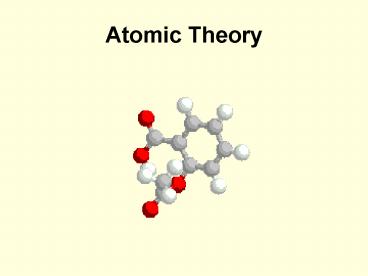Atomic Theory - PowerPoint PPT Presentation
1 / 31
Title:
Atomic Theory
Description:
John Dalton. Ernest Rutherford. Atomic Theory. 400 BC 1803 1904 1910 1913 1926 Title: Atomic Theories Timeline Author: Ron Last modified by: Pampa Created Date: – PowerPoint PPT presentation
Number of Views:410
Avg rating:3.0/5.0
Title: Atomic Theory
1
Atomic Theory
2
Lets Take a Trip Through Time!
3
Democritus460 370 B.C.
- There are various basic elements from which all
matter is made - Everything is composed of small atoms moving in a
void - Some atoms are round, pointy, oily, have hooks,
etc. to account for their properties - Ideas rejected by leading philosophers because
void no existence
4
First Concept of an Atom
5
John Dalton1766-1844
- Each element is composed of extremely small
particles called atoms - All the atoms of a given element are identical,
but they differ from those of any other element - Atoms are neither created nor destroyed in any
chemical reaction - A given compound always has the same relative
numbers and kinds of atoms
6
Daltons Atomic Theory (1808)
1. Elements are composed of extremely small
particles called atoms. 2. All atoms of a
given element are identical, having the same
size, mass and chemical properties. The atoms of
one element are different from the atoms of all
other elements. 3. Compounds are composed of
atoms of more than one element. In any compound,
the ratio of the numbers of atoms of any two of
the elements present is either an integer or a
simple fraction (Law of Definite Proportion). 4.
A chemical reaction involves only the separation,
combination, or rearrangement of atoms it does
not result in their creation or destruction.
7
Daltons Model
8
Law of Multiple Proportions
9
Law of Conservation of Mass
8 X2Y
10
Modern Atomic Theory
- Atoms cannot be subdivided, created, or
destroyed. - Atoms can be destroyed via nuclear reactions but
not by chemical reactions. - Atoms of a given element are identical in size,
mass, and other properties - There are different kinds of atoms (differing by
their masses) within an element that are known as
"isotopes.
11
J.J. Thomson(Discovery of Electron)1856-1940
- Discovered electron 1897 Cathode Ray Experiment
- Plum Pudding model 1904
- Electrons in a soup of positive charges
- Discovered isotopes 1913
12
Discovery of Electron
- J. J. Thomson(1897)
- British physicist at Cambridge University
- Cathode Ray Experiment Hypotheses
- Cathode rays are charged particles (which he
called "corpuscles"). - These corpuscles are constituents of the atom.
- Observation
- -the rays bended with a magnet
- -the electrometer measured a large amount of
negative charge
13
Cathode Ray Tube
J.J. Thomson, measured mass/charge of e- (1906
Nobel Prize in Physics)
14
The Electron
- J.J. Thomson 1897 - CRT experiment
- Negative Charge
- e-
- Actual Mass 9.11 x 10-28g
- Relative mass information - discovered later
1/1840 the mass of proton
15
Plum Pudding Model
16
Millikans Experiment
Measured mass of e- (1923 Nobel Prize in Physics)
e-
charge -1.60 x 10-19 C Thomsons charge/mass of
e- -1.76 x 108 C/g
e- mass 9.10 x 10-28 g
17
Ernest Rutherford1871-1937
- Nucleus Theory 1910
- alpha particle gold foil experiment
- An atoms mass is mostly in the nucleus
- The nucleus has a positive charge (Moseley)
- Electrons in fixed orbit
18
Rutherford Gold Foil Experiment
- Bombard the gold foil with alpha
particles,positively charge particles w/ 4x of
the mass of H - Only expectslight deflection
- EvidenceWide-angledeflection
- Click for Interactive Demonstration
19
Experiment Conclusion
- atoms positive charge is concentrated in the
nucleus - Volume of a nucleus is very small compared with
the total volume of an atom - The nucleus is heavier than electron
- Suggested that the atom might resemble a tiny
solar system, with a massive, positively charged
center circled by only a few electrons - proton (p) has opposite()charge of electron (-)
- mass of p is 1840 x mass of e- (1.67 x 10-24 g)
20
Rutherford Model
21
James Chadwick1891-1974
- Worked with Rutherford
- Interpreted work of the Curies
- Discovered Neutron 1932
- Nobel Prize in Physics 1935
22
Chadwicks Experiment (1932)(1935 Noble Prize in
Physics)
H atoms - 1 p He atoms - 2 p mass He/mass H
should 2 measured mass He/mass H 4
neutron (n) is neutral (charge 0) n mass p
mass 1.67 x 10-24 g
23
The Neutron
- Chadwick 1932 - nuclear bombardment
- No charge
- n0
- Actual Mass 1.67 x 10-24g
- Relative Mass 1
24
Niels Bohr1885-1962
- Planetary Model 1913
- Nucleus surrounded by orbiting electrons at
different energy levels - Electrons have definite orbits
- Utilized Plancks Quantum Energy theory
- Worked on the Manhattan Project (US atomic bomb)
25
Bohrs Model
26
Bohr Model for Nitrogen
27
Ernst Schrödinger 1887-1961
Werner Heisenberg 1901-1976
- Quantum Mechanical Model 1926
- Electrons are in probability zones called
orbitals, not orbits and the location cannot be
pinpointed - Electrons are particles and waves at the same
time - Developed quantum numbers based on theories of
Einstein and Planck
28
Orbitals
29
Quantum Mechanical TheoryElectron in a Hydrogen
atom
30
Atomic Theories Timeline
Name Democritus Dalton Thomson Rutherford Bohr Schrödinger Heisenberg
Time Frame
Key Points
Historical Events
31
(No Transcript)































